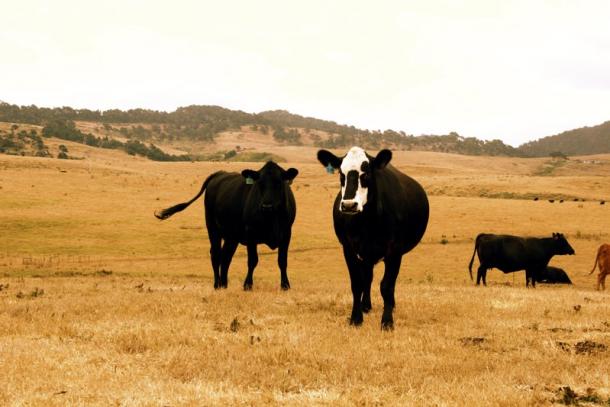Drought Forces Tough Decisions
Brie Mazurek, CUESA Staff
February 7, 2014

While recent rains may have city dwellers bundling up and heading for cover, the much-needed precipitation is a godsend for farmers, as California faces its worst drought in decades.
Ranchers, who require green pasture to feed their livestock, have been among the hardest hit by the lack of rain this winter. Many have had to resort to slaughtering or selling off herds, or buying supplemental feed. With hay in such high demand, prices have skyrocketed in the last few months, while much of the quality hay is being exported overseas at a premium.
At Achandinha Cheese Company in Petaluma, the Pacheco family has had to sell off 30 of their heifers because they cannot afford to feed them. “It’s going to be another year before they’re ready to be impregnated,” says Donna Pacheco. “The thought of feeding them for another year—we can’t do it.”
With reserves low, the Pachecos will have to haul in water for their livestock to drink, an added cost. The lack of rain has forced them to purchase hay to feed their dairy cows and goats, which is expensive and contains less nutrition than fresh pasture. “I can clearly see a difference in their body structure,” says Donna. “They’re falling behind because they don’t have pasture.”
Using supplemental feed also affects the distinct flavors of their farmstead cheeses, which result from seasonal variation in the plants the goats normally forage for in the fields, Donna notes. “We’re not going to have those seasonal changes because we’ve been feeding them the same hay for some time.”
Seeking Greener Pastures
As of Wednesday, Marin Sun Farms owner David Evans said their Point Reyes ranch had received only three inches of rain this winter, compared to the typical 15 to 20 inches. The ranch relies exclusively on rainfall to irrigate the pasture that their grass-fed cattle depend on.
“Winter is always the most difficult time of the year for pasture availability and quality,” says David. To offer a year-round supply of grass-fed beef, Marin Sun Farms works with a network of Northern California ranchers, known as “co-producers,” who adhere to similar principles for pasture-raised cattle. “But this year the pastures are not growing, and grasses are dormant.”
Marin Sun Farms remains committed to offering grass-fed and -finished beef as much as they are able, but due to the dry season, some of their pasture-raised beef must be fattened with supplemental grain-based feed, adding to their operational costs.
High and Dry
Greg Massa and Raquel Krach of Massa Organics grow rice and almonds and raise pigs and lamb on their farm in Hamilton City. Managing such diverse demands for water can be a difficult balancing act, which the drought has intensified.
“The biggest impact right now is that the winter crops that we planted—cover crops, hay, wheat, barley—have either not germinated or did germinate but are stressed to the point where they look like they’re dying,” says Greg. Winter cover crops provide an important link in the farm’s fertility cycle, putting nitrogen and organic matter into the soil to nourish summer crops like rice. Without them, the farm will have to purchase manure and compost. Crops like hay and wheat provide feed for their pigs.
“If I include the 13 that were born last night, we’re up to about 170 pigs,” says Greg. “We don’t know how we’re going to raise up those two sets of piglets if we don’t have feed for them. We’re going to have to start culling those animals because we can’t afford to buy feed.” This could mean butchering pigs that have reached market weight and selling off the younger ones. “We have stopped our breeding until we can figure out what’s going on.”
Balancing Competing Needs
With water scarce and future supplies difficult to predict, Greg and Raquel choose wisely which crops to plant this year. They have already decided not to plant safflower, which they planned to use for pig feed and biodiesel. They’re also wondering whether they should plant rice, their cash crop, this summer or plant a less water-intensive crop instead. “But if we don’t grow rice, we lose our customer base,” says Greg.
The drought has also added a layer of uncertainty to the farm’s carefully planned crop sequences. Half of their fields rely on water from the government-run irrigation district, which could be cut by 50% or more this year. “We have our wheat and barley crops on a field that can be irrigated by the well,” Greg explains. “That’s good, except that wheat and barley get harvested in late June or early July, which means that we can’t then use that field for rice, because that’s too late to plant rice. We’re going to have to put our rice in the irrigation district part of land, where we may not have water for it at all.”
“Do we let the wheat grow out and harvest the grain to feed the pigs, or do we till it in and plant rice?” he wonders. “It’s just very complicated right now because we don’t know how much water we’re going to have.”
The current wet spell may provide a brief respite, allowing seedlings to take root, but it will take much, much more rain to put farmers’ minds at ease. “You can’t control the weather, so it’s not worth stressing out too much,” says Greg. “But on the other hand, you can’t really help it.”
Don’t let a little rain keep you away from tomorrow’s market! Support our farmers through the drought by shopping at the farmers market rain or shine.
Topics: Animal welfare, Farmers, News, Water
